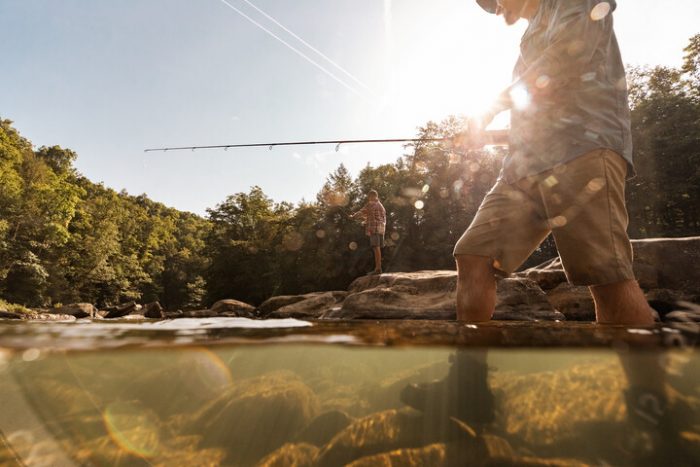Family: Percidae
Common Family: The Perch Family
Common Name: Walleye
Scientific Name: Stizostedion vitreum
Ecological Description/Identification
Walleye are a toothy, elongate fish with two separated dorsal fins and very large eyes. They are yellow-olive green in color with streaks and blotches of dark pigment. The underside of this fish is white. The spiny dorsal fin can be dusky or clear but usually has a black blotch at its base. They also have a white tip on the lower lobe of the tail.
In the late 1990’s, the walleye found in the New River were found to be a unique genetic strain totally different from walleye found in other places such as Lake Erie. The native strain has larger eggs, the fry are more aggressive, and they grow to large sizes.
Habitat
Walleye are native to West Virginia and are considered a cool-water species. They are usually found near the bottom in large, cool-water rivers and reservoirs. Walleye usually spawn in early spring over rocky bottoms in riffle or run areas of rivers and at the head of reservoirs, although they may spawn on windswept, rocky shorelines in lakes and reservoirs. During summer months, they usually seek out cooler water in deeper portions of reservoirs and rivers or areas of current. Feeding habitat is diverse and can be near woody structure, submerged vegetation, rocky habitat or even over soft bottoms.
Conservation Issues
Historically, blockage of upstream spawning migrations by dams and poor water quality from acid mine drainage negatively impacted walleye populations. Also, sedimentation of rocky bottoms can impact walleye by covering spawning areas. Overharvest of fish, especially spawning females, can also reduce populations.
Facts
Walleye have been noted for their quality meat as a food fish. Adult walleye eat primarily fish, and often prefer yellow perch or gizzard shad. Walleye are generally found near the bottom and may be associated with cover such as woody debris, rocky areas or vegetation. Walleye have excellent vision during low-light and are most active during cloudy days and at dawn and dusk. Covering large areas using trolling techniques and rigs such as bottom-bouncers or jigging with soft plastic swimbaits, or deep diving crankbaits are effective fishing strategies. Walleye can reach lengths of over 30 inches and may have a minimum length limit or protected slot limit depending on the water you are fishing.
The West Virginia length record for Walleye is 35.0 inches (Fred Cline, 1976) and the weight record is 18.97 pounds (Jerry Rose, 2004).
Similar Species
Walleye and sauger are very similar in shape. However, they are easily distinguishable by the white-tipped lower caudal lobe and dark dorsal spot present in walleye and absent in sauger. Sauger will also have multiple brown blotchy saddles throughout the body that is absent in walleye.



